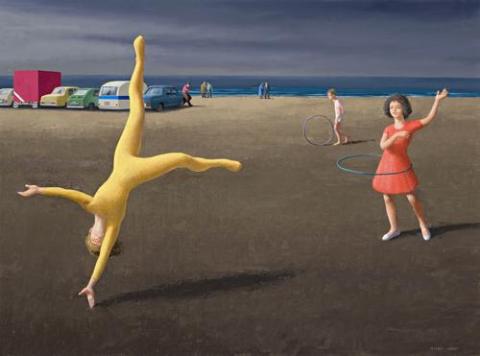WAITING FOR THE HOVERCRAFT, BOULOGNE, 1986 - 87
Jeffrey Smart
oil on canvas
67.5 x 91.0 cm
signed lower right: JEFFREY SMART inscribed verso: Waiting for the Hovercraft, Boulogne
Australian Galleries Melbourne (label attached verso)
Private collection, Melbourne
Sotheby's, Melbourne, 7 May 2001, lot 29
Private collection, Sydney
Jeffrey Smart, Rex Irwin Art Dealer, Sydney, 3 - 21 November 1987, cat.15 (illus.)
Jeffrey Smart, Australian Galleries, Melbourne 1989, cat.29
Amadio N., 'Smart intellect shines through', Sunday Telegraph, Sydney, 8 November 1987, p.142
Lynn, E., 'Jeffrey Smart: relishing life's ironies', The Weekend Australian, 14-15 November 1987, p.12
McDonald, J., Jeffrey Smart: Paintings of the '70s and '80s, Craftsman House, Sydney 1990, p.161, and cat.319
Pearce, B., Jeffrey Smart, The Beagle Press, Sydney. 2005, p.199 (illus.)
First study for 'Waiting for the Hovercraft, Boulogne', 1986/87, oil on canvas, 32.0 x 44.0 cm (McDonald, cat.317); Second Study for 'Waiting for the Hovercraft, Boulogne', 1985/86, oil on canvas, 35.0 x 47.0 cm (McDonald, cat.318)
One of the many constants in the art of Jeffrey Smart is travel- trucks and cyclists on roads, garages, overpasses, trains and railways, airports, seaports and hovercraft terminals, as in the one at Boulogne. Not surprisingly, Smart enjoys travel, around Europe, the Greek isles, and visits to Australia for his exhibitions. The paradox is that his subjects are like still life, nothing moves, as if frozen in a time outside itself. What could be more full of movement than the acrobatic figure in this painting? People do not freeze in the air, nor do hoops remain motionless- except in a Smart painting. Smart has claimed in the past that he introduces figures into his compositions for scale; but you must keep them under control or they will tempt the eye away from all else. Not here. They are the focus, which, combined with the absence of autobahns and buildings, makes this such an interesting painting, readily acknowledged by the art critics when first exhibited in Sydney. An important change took place between the first study, with its sublimated buildings and sea walls, and the final version. Now, cars, a caravan and truck, although present, are dismissed to the near horizon, the figures in the distance more references of measurement. The landscape has that slightly eerie, expectant quality that we know so well, a stage for performers, the perfect setting for something to happen. The three are young and the focus of attention. Growing as they come closer, and coloured to seduce the eye, the realism of the unreal pose playing a game of illusion and abstraction. As always in the best of Smart, the composition is a consummate balance.
DAVID THOMAS
